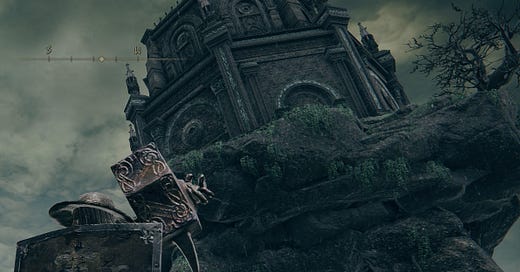Like a huge number of gamers (and architects) around the world, I’ve been playing Elden Ring (or as my wife calls it Elder Rings) and it’s the only From Software game that I have continued to play past the second boss. I am not a patient gamer. I haven’t beaten it, and I probably haven’t even seen half of the game yet, but I think I’ve seen enough to comment on the architectural design and it. is. chaotic.
I wish I had the time to read the lore (like I used to in my Destiny 2 days), because I’m sure there are hundreds upon hundreds of lore Easter Eggs (happy Easter, gang) hidden in the ornamentation and details of the buildings in the Land Between (the continent in Elden Ring). George R.R. Martin created a significant portion of the lore, so it’s probably, maybe, sort of interesting? My critique will mostly focus on the bravery of some of the immediately recognizable building features. Sorry for those of you hoping for a deep dive, but until building construction decides to cool it for a couple months, you’ll have to settle for shallow critique. Also, goes without saying, but there will be some spoilers for the first half of Elden Ring.
Elden Ring juggles several architectural theories and I want to break down two of them.
Form Follows Function.
See my post on Louis Sullivan for some words on Form Follows Function
The first idea I recognized was the embrace of “Form Follows Function”, even if it has been modified to fit a fantasy setting. Most of the buildings in the Lands Between were Gothic in form and program. Formally the buildings were draped in ornament prevalent in Gothic churches such as the Milan Duomo.
Programmatically most of the buildings were castles or churches or castles with churches or walking chapels with truck nuts or institutional academia. In a true form follows function format, the religious and governmental structures were covered in creepy Gothic ornamentation.
Prospect-Refuge Theory
A coworker was talking about the prospect-refuge aesthetic theory first proposed by Jay Appleton, and it occurred to me that Elden Ring explicitly expresses the tenants of prospect-refuge theory with different architectural vernaculars.
1.Prospect (Opportunity)
Prospect is expressed in a view of something from a distance that creates a desire to explore. Breath of the Wild was incredibly good at expressing this idea. In Elden Ring grants incredible views across magnificent landscapes, while expressing Prospect with the use of Gothic vernacular architecture. Every time Gothic architecture is displayed, it is time to die 18 times to see what is in that building (hint, it’s a gold rune, it’s always a gold rune).
2. Refuge (Safety)
Refuge allows the viewer to gaze at a prospect without fear if interruption. This gives us the opportunity scan the horizon and plan before setting off on a journey. A chance to bask in the details of life without having to worry about a zombie dog ripping your arm off (again). Elden Ring uses bonfires (also used in basically every From Software game) to express these safe spaces, but vernacularly these are often expressed with makeshift camps, wooden huts, and ruined chapels. Sometimes these are accompanied by magnificent views and sometimes they are directional to the next boss. Always, they are a relief to the player.
I will say that I have noticed some shoddy modeling in Elden Ring. Asymmetrical column layouts, inconsistent ornamentation, terrible distortion of column orders, bad materiality, etc. I think the experimentation in architectural theory certainly makes these sins easily forgivable, but they are noticeable enough to mention.
Due to my tumultuous relationship with From Software games I came into the game deeply skeptical that I would play the game for enough time to create even a vignette of a critique. Despite the gameplay frustrations, the worldbuilding and architectural experimentation has been thrilling. After all, suffering makes the refuge that much sweeter.
A few interesting conditions that did not fit in this story:



















